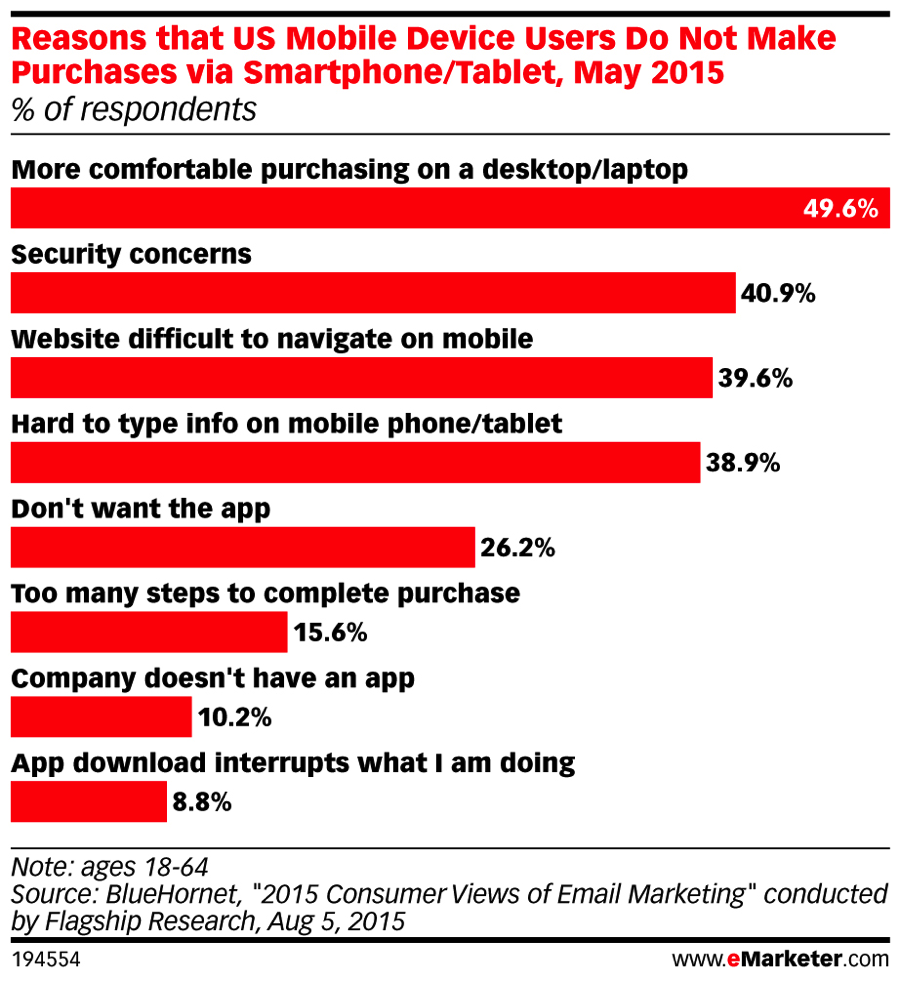
 In 2015, more than 60 percent of people in the United States use a smartphone, up from 35 percent in in 2011. And while smartphones continue to be used primarily for text messaging, calls, email, and Internet browsing, connected devices will dramatically impact the shopping experience and shopper behavior. In fact, six percent of smartphone users in the U.S. report having trouble shopping without their smartphones. Perhaps this is why, according to Google, mobile searches influenced 28 percent—nearly $1 trillion—in retail sales during the 2014 holiday shopping season.
In 2015, more than 60 percent of people in the United States use a smartphone, up from 35 percent in in 2011. And while smartphones continue to be used primarily for text messaging, calls, email, and Internet browsing, connected devices will dramatically impact the shopping experience and shopper behavior. In fact, six percent of smartphone users in the U.S. report having trouble shopping without their smartphones. Perhaps this is why, according to Google, mobile searches influenced 28 percent—nearly $1 trillion—in retail sales during the 2014 holiday shopping season.
READ MORE: Four shopping behaviors to test this holiday season
Clearly, accounting for mobile shoppers is important but beyond this, you must gain insight into the relationship between customer behaviors on multiple channels. To better understand shoppers in 2015, it’s important to consider some of this mobile and cross-channel behavior more closely.
According to a recent survey conducted by BlueHornet, only 18.5 percent of shoppers reported being “very likely” to complete a purchase via smartphone or tablet. With mobile representing an increasing share of total traffic, this finding may be disheartening. However, when placed in a greater context, it is more encouraging.
In a survey conducted by Signal, for example, 67 percent of respondents said they plan to browse more frequently from smartphones or tablets than they did during the last holiday season. At the same time, research conducted by UPS has found consumers use smartphones to conduct research 41 percent of the time, while only 30 percent used the same device to make a purchase. ![]()
This reinforces the common assumption that shoppers conduct research on their phones but prefer to make purchases on the desktop. Optimizing mobile sites for browsing, product discovery, and comparison while streamlining desktop sites for conversion may address the different needs associated with the two devices. Addressing key challenges that prevent mobile users from converting, however, may lead to a smartphone experience that is more enjoyable and profitable.

In the BlueHornet survey mentioned above, nearly half of all respondents said they were more comfortable purchasing on a desktop or laptop. This is a fairly vague response, but the following three most popular responses make it clear that security concerns (40.9 percent) and usability issues related to navigation and checkout form filling (39.6 percent and 38.9 percent, respectively) represent the most significant specific challenges.
Concerns over security, trouble navigating, and challenges to information entry were reiterated by respondents in the survey conducted by UPS. At the same time, challenges to product evaluation, including difficulty reading product information, comparing products, and getting a clear view of the product image were also significant.
No discussion of mobile shopping behavior is complete without a consideration of webrooming and showrooming. Interestingly, webrooming—the act of researching products online then purchasing in a physical store—was more common among parents, with 66 percent reporting the behavior, than students during this year’s back-to-school shopping season. Concerns over delivery may play a role in this behavior. Research from UPS found that as the price of shipping increases, the expectation for speedy delivery among online shoppers also increases. At the same time, ship-to-store options appear to be increasing in popularity with 38 percent of shoppers reporting that they have used the benefit in 2015.
When it comes to showrooming—shopping online while in a store—price proves to be the biggest motivator. When shoppers are asked why they purchase an item online after seeing it in a physical store, 57 percent say they found a better price online from a different retailer. Conducting additional research, however, drives 46 percent of shoppers online. This is supported by research that identifies the primary reasons shoppers turn to their phones in a store as a desire to look up product reviews, read more product details, or search for product alternatives.
By considering these shopper behavior trends, it’s possible to create more relevant and effective tests. Adapting a site design to accommodate mobile users is one thing, but tailoring desktop and mobile designs to the specific behaviors observed across channels will help you optimize your site before the biggest—and most important—season of the year.
Categories









